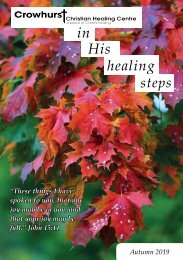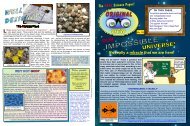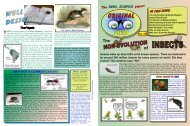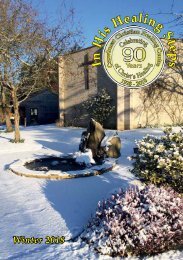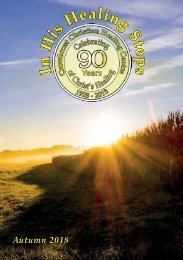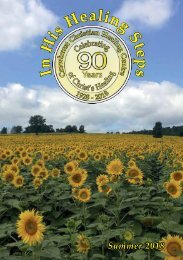CRT-126
CRT-126
CRT-126
You also want an ePaper? Increase the reach of your titles
YUMPU automatically turns print PDFs into web optimized ePapers that Google loves.
CHRISTMAS Tree Worms live in the world’s warm<br />
oceans. They get their name from two coloured spirals<br />
of feathery gills, which are actually part of their mouth.<br />
When their eggs hatch, the larvae settle on a coral reef,<br />
bore a deep hole, and stay hidden until they become adults.<br />
This will be their permanent home, and they will never move<br />
from this spot. As they grow they create a hard tube around<br />
themselves for extra protection. They sometimes live as<br />
long as 40 years!<br />
Christmas Tree Worms feed on microscopic<br />
water creatures called phytoplankton.<br />
They trap them in those<br />
feathery gills, which they also use for<br />
breathing. Any sand grains that are<br />
collected are stored in sacs and used<br />
for building their protective tubes.<br />
They disappear back into their burrow if<br />
some other creature comes along.<br />
Another of these<br />
colourful creatures<br />
They even have a tiny lid which they<br />
close for extra protection.<br />
These worms come in a number of<br />
MANY people say that it’s impossible for a true scientist to<br />
believe in God and the Bible, and that all scientists<br />
believe life came through evolution. This is not true, because,<br />
as we have seen in this paper, the most famous scientists of<br />
the past, who made some of the most important discoveries<br />
about our world and universe, believed in God and the Bible.<br />
There are hundreds of true scientists living today who believe in<br />
God. They also believe that the first book of the Bible, Genesis, tells the truth about how<br />
the world began, and that the evolution theory is false. Those past and present scientists<br />
would agree with some words written 2,600 years ago by Jeremiah: “The Lord made the<br />
earth by his power. He used his wisdom to build the world. He used his understanding to<br />
stretch out the skies.” (Jeremiah 51: 15).<br />
We now know even more than the famous scientists of the past. Powerful telescopes and<br />
microscopes have revealed that our world and universe are even more amazing than<br />
anyone ever believed. This means that time and chance could never have made our world<br />
the way it is. All the evidence points to a wise and powerful Creator.<br />
Maybe you can become a scientist when you grow up, and help to<br />
discover more of the wonders of God’s world!<br />
Christians believe that the God who made everything cares about us<br />
and loves us so much that He sent His Son Jesus to earth to bring us<br />
into His family. The Bible says, “Jesus died in our place to take away<br />
our sins. And Jesus is the way that all people can have their sins taken<br />
away.” (1 John 2: 2). After He died, Jesus rose from the dead. Through<br />
faith in Him we are forgiven for all the wrong things we have done, and<br />
can live with God for ever in the new creation He has promised.<br />
A pair of colourful Christmas Tree Worms<br />
different colours. Divers who watch them<br />
popping out of their burrows say it looks like<br />
a colourful firework display!<br />
There is no evidence that Christmas Tree<br />
Worms evolved from anything else. And<br />
why would evolution produce something so<br />
beautiful which could only be seen by<br />
divers? We believe God, who loves beauty,<br />
created these weird yet beautiful worms.<br />
PUZZLE ANSWERS<br />
JUMBLED WORDS:<br />
1. Factory. 2. Maggot. 3.<br />
Insects. 4. Bacteria. 5.<br />
Plants. 6. Geology.<br />
BIBLE VERSE:<br />
“The sky was made at the<br />
Lord’s command.”<br />
(Psalm 33: 6)<br />
Photos by Nick Hobgood: Creative Commons LIcence<br />
Includes graphics from Clipart.com,<br />
Scriptures quoted from The Holy Bible,<br />
New Century Version®. Copyright ©<br />
2005 by Thomas Nelson, Inc.. Used by<br />
permission. All rights reserved.<br />
Our World is published three times<br />
a year by the Creation Resources<br />
Trust (Reg. Charity No.1016666).<br />
Editing, design and layout by Geoff<br />
Chapman. Unless otherwise stated,<br />
articles are written by the editor.<br />
There is no subscription charge, but<br />
donations towards costs are invited.<br />
For more information about this,<br />
and other resources, please contact<br />
<strong>CRT</strong> at P O Box 3237, Yeovil,<br />
BA22 7WD, UK. Phone: 01935<br />
850569. Email: info@ crt.org.uk<br />
Web site: www.crt.org.uk<br />
© 2019 <strong>CRT</strong><br />
Printed by CPO Worthing<br />
Dutch scientist Antonie van Leeuwenhoek<br />
(above), who lived from 1632 to 1723,<br />
invented powerful microscopes. He was the<br />
first man to see tiny things like bacteria, and<br />
microscopic water creatures called<br />
Foraminifera (below). As a<br />
Christian he loved the truth,<br />
and often spoke about great<br />
and small creatures as the<br />
wonders God had created.<br />
His microscopes revealed<br />
that God’s world was even<br />
more wonderful than anyone<br />
could have imagined.<br />
OUR<br />
Our most famous scientists<br />
believed they were discovering<br />
what God had created!<br />
SEEING GOD IN THE LARGE AND SMALL<br />
For hundreds of years scientists have been<br />
finding out more and more about the<br />
wonders of God’s creation. They have<br />
examined large things like galaxies through<br />
telescopes and small things through<br />
microscopes. No wonder most scientists in<br />
the past felt sure that all these wonders<br />
were the work of God.<br />
As more and more powerful telescopes<br />
and microscopes have been invented, we know that our world<br />
and universe are even more amazing than was once believed,<br />
and it seems even more impossible to<br />
believe that all of this happened without<br />
a Creator. Yet many scientists now tell<br />
us that it all happened by chance! Is<br />
this because they don’t want to believe<br />
in the God who created everything?<br />
Those famous scientists of the past<br />
would have found this very strange!<br />
Priest/scientist who lived 1,300 years ago knew the earth was “like a ball.”<br />
The Venerable Bede (left) was an English priest, historian<br />
and scientist who lived between 673 and 735 AD. He<br />
calculated that God created the world about 4,000 years<br />
before Jesus was born, and helped set up the calendar we<br />
now use, starting from Jesus’s birth. Bede showed how<br />
ocean tides are mainly caused by the moon, and said that<br />
the earth was a “globe … not circular like a shield but<br />
rather like a ball.” This means that the idea that most<br />
ancient people believed the earth was flat is a myth. In<br />
2009 a special exhibition called “Bede, the Scientist” was opened at Jarrow, in<br />
north-east England.* 20th century astronomer Sir Patrick Moore called Bede “The<br />
first great British astronomer,” and believed it was important for people, especially<br />
children, to know more about his work. *www.jarrowhall.org.uk<br />
ALSO IN THIS ISSUE:<br />
Strange ideas about life’s<br />
beginning<br />
Nature Notes: Leaves<br />
Scientists who recognised<br />
God’s creation as they<br />
studied planets, insects,<br />
plants and animals.<br />
Geologist who believed<br />
rocks and fossils were<br />
formed quickly<br />
Puzzle Corner<br />
Weird and Wonderful:<br />
The Christmas Tree Worm<br />
Seeing God in His word and<br />
His world
STRANGE IDEAS ABOUT LIFE’S BEGINNING!<br />
The idea that life came from what was not<br />
alive has been around for hundreds of years.<br />
It’s called spontaneous generation. Once,<br />
people believed that frogs and worms came<br />
from mud. Others said that maggots came<br />
from rotting meat. That was before people<br />
understood that<br />
maggots come from<br />
eggs laid by flies.<br />
Scientists proved<br />
that the idea that life can come from<br />
non-living matter was wrong. One of<br />
them was Louis Pasteur (left), who lived<br />
in France in the 19th century, and<br />
believed in God and the Bible. He showed<br />
that if broth is boiled, then placed in a<br />
sealed flask it will remain lifeless,<br />
because no bacteria from<br />
the air can get in. That’s why<br />
food sealed in tins won’t go<br />
bad unless it’s opened.<br />
Many modern scientists<br />
believe that, millions of years ago, life began in the oceans in a<br />
kind of chemical “soup.” Louis Pasteur’s experiments showed that<br />
this could never have happened. Life only comes from life!<br />
Public Domain Pictures<br />
Dr Louis Pasteur said:<br />
“The more I study nature,<br />
the more I stand amazed<br />
at the work of the<br />
Creator.”<br />
By Nemati: RGBstock.com<br />
Some frogs live in mud,<br />
but they don’t come<br />
from mud!<br />
Have you ever noticed how many different patterns of leaves there are on trees<br />
and other plants? Leaves are usually very thin, but if you viewed a leaf under a<br />
microscope you would see that it has several layers beneath<br />
its tough skin. In fact, each leaf is like a tiny factory which<br />
converts sunlight into sugar, glucose and<br />
Top skin<br />
sucrose to provide food for the plant.<br />
Leaves also have a network of veins (left),<br />
These not only strengthen the leaf but<br />
carry water from the stem to different<br />
parts of the leaf, and also carry food to<br />
the main part of the plant. Evergreen trees keep their leaves all<br />
year round, but deciduous trees lose their leaves in the autumn,<br />
when they produce a beautiful display of colour.<br />
Next time you go for a walk, look out for the many different<br />
shapes and sizes of leaves. Look closely and see the pattern of<br />
veins. Then<br />
Some of the many different kinds of leaves<br />
Famous French scientist<br />
Jean-Henri Fabre<br />
(1823-1915) devoted<br />
his life to the study of<br />
insects. He loved<br />
nature, and was especially<br />
attracted to the<br />
beauty of butterflies.<br />
He published his work in a 10-volume<br />
encyclopedia, and his research<br />
and discoveries are still praised by<br />
scientists. Though his achievements<br />
were great, he pointed to God as his<br />
inspiration. He did not believe in<br />
Charles Darwin’s evolution theory,<br />
which he called “a<br />
craze”, and gave<br />
God the praise for<br />
creating such a<br />
beautiful world.<br />
Fabre (left) said:<br />
”You could take<br />
my skin from me<br />
more easily than<br />
my faith in God.”<br />
Lower skin<br />
Diagram of the layers of a leaf<br />
remember what<br />
you can’t see without a microscope —that wonderful<br />
system that changes sunlight into energy. God created<br />
leaves in the beginning, when He said: “Let the earth<br />
produce plants. Some plants will make grain for seeds.<br />
Others will make fruit with seeds in it. Every seed will<br />
produce more of its own kind of plant.” And it<br />
happened. “(Genesis 1: 11). —Geoff Chapman<br />
By Salongley: Wikipedia Commons<br />
SCIENTIST BELIEVED THAT ROCKS FORMED QUICKLY<br />
Danish scientist Nicolas Steno (left), who lived from 1638<br />
to 1686, was one of the first people to make a serious<br />
study of geology (how rocks are formed). At the time,<br />
many people believed that fossils<br />
had either grown inside the<br />
rocks or were objects that had<br />
fallen from the sky. Steno believed<br />
that fossils are the remains<br />
of plants and animals<br />
which once lived on earth, before dying and<br />
becoming buried in the rocks, and that the<br />
rock layers were formed very quickly so that<br />
these animals and plants could be preserved.<br />
Steno was a Christian, who believed that the<br />
Bible tells us the true history of the world, and<br />
Steno believed that rocks<br />
must have been formed<br />
quickly to preserve plants<br />
and animals as fossils<br />
that most of the rocks and fossils were formed in the worldwide flood of<br />
Noah’s time. In 1667 Steno became a Bishop, but he still continued to be<br />
interested in science. Modern geologists remember Nicolas Steno as one<br />
of the founders of modern geology, whose ideas on how rocks form are<br />
still accepted.<br />
SOLAR SYSTEM IS “THE WORK OF A WISE CREATOR”<br />
Man who listed plants and animals<br />
Swedish scientist Carl<br />
Linnaeus (right), who<br />
lived 1707–1778,<br />
invented a way of<br />
listing plants and<br />
animals which is still<br />
used today. He began<br />
studying plants when he was 8 years<br />
old, and eventually listed around<br />
4,400 species of animals and 7,700<br />
species of plants, putting them<br />
together in groups or “kinds”. For<br />
example, dogs, wolves, coyotes, and<br />
jackals are part of one kind. Linnaeus<br />
was a Christian who rejected<br />
evolution. He believed that the<br />
different “kinds” of animals and plants<br />
were created in the beginning by “the<br />
almighty Creator, the all-knowing,<br />
immeasurable and eternal God.”<br />
SOLAR SYSTEM<br />
Most of the early astronomers, who made some great discoveries about<br />
stars and planets, believed they were studying and discovering God’s<br />
work. Johannes Kepler who lived between 1571 and 1630 said that the<br />
way the planets of our solar system move was<br />
the work of a “wise Creator.”<br />
One of our most famous scientists, Sir Isaac<br />
Newton, who lived between 1643 and 1727,<br />
said that our solar system could only have come from “an intelligent and powerful<br />
Being.” He believed it was “senseless” to believe that life on earth happened by<br />
accident, and not to believe in a Creator. He wrote: “There is a being who made<br />
all things and has all things in his power.” Most modern scientists praise what<br />
Johannes Kepler Issac Newton Kepler and Newton did, but sadly they don’t share their belief in a Creator.<br />
Take the first letter of each object below to spell a Bible verse<br />
Use the clues from this magazine<br />
to unjumble the words below:<br />
TRYOFAC Every leaf is like one<br />
STAGGOM People once thought these<br />
came from rotting meat<br />
SCETINS French scientist Jean-Henri<br />
Fabre studied these<br />
CATREBIA Dutch scientist Antonie van<br />
Leeuwenhoek was the first to see<br />
them<br />
YOGLEGO Nicolas Steno studied this<br />
BLOGE The Venerable Bede believed<br />
the earth was like one of these<br />
(Answers on the next page)<br />
www.crt.org.uk



